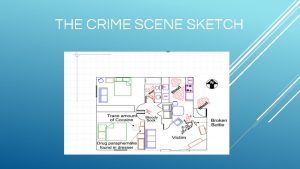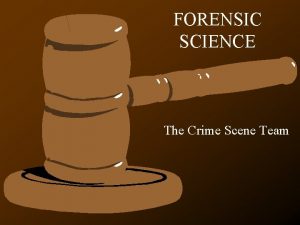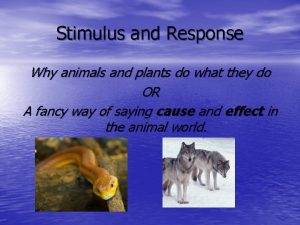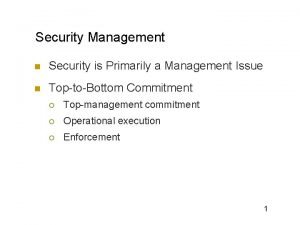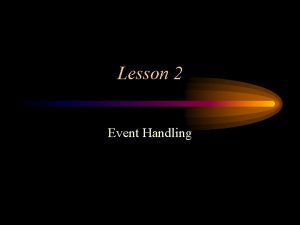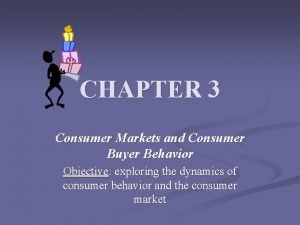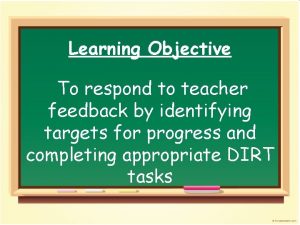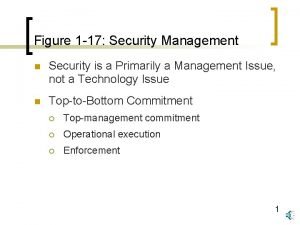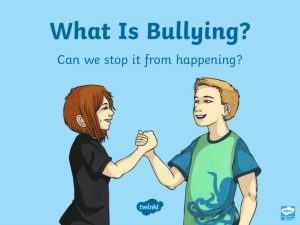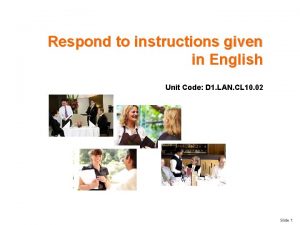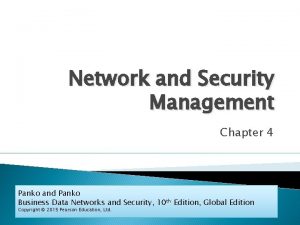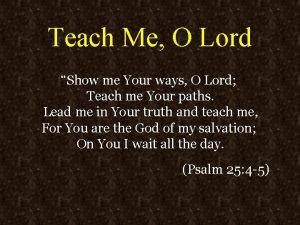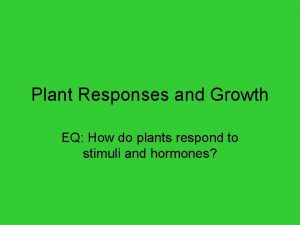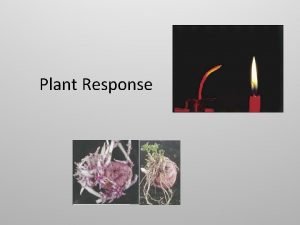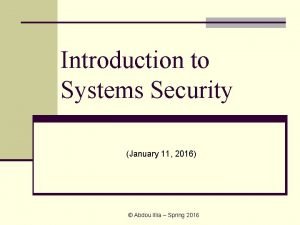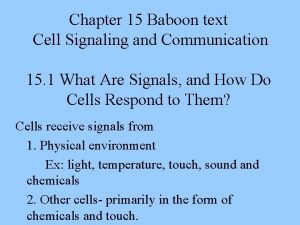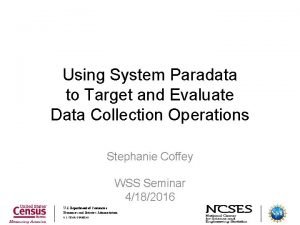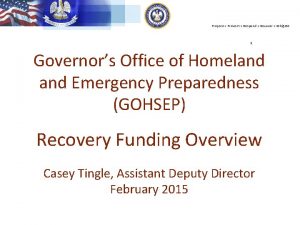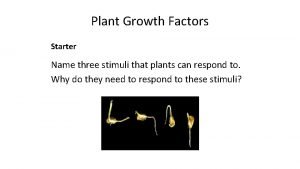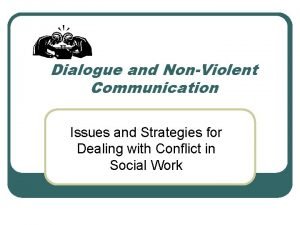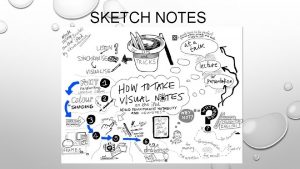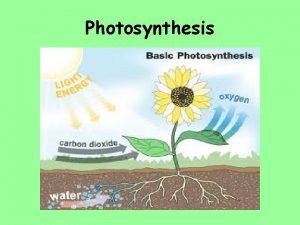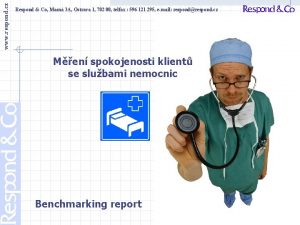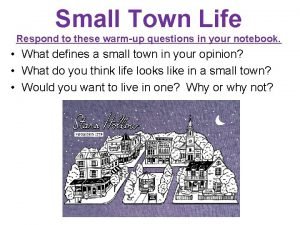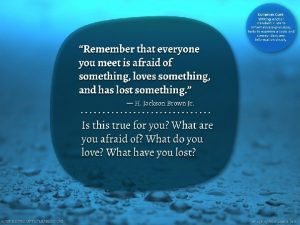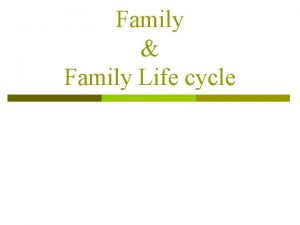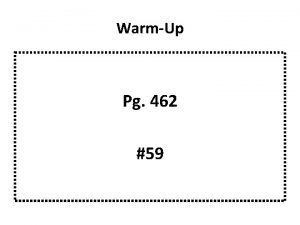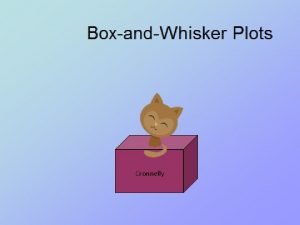WarmUp Life Sketch Read Life Sketch Respond Family














































- Slides: 46

Warm-Up… • Life Sketch… – Read Life Sketch – Respond

Family Crisis & Violence Child Guidance

What is a crisis? • Crisis= an unforeseen situation that demands adjustment by all members of a family. • A crisis may consist of a single event such as the loss of a job. • Other crises are long term that require a family to cope. Such as substance abuse, child abuse, or domestic violence. Do all families experience crisis?

Dysfunctional Families • A dysfunctional family is one that cannot function properly because of certain overwhelming problems. • These problems can prevent parents from being able to care for and nurture children. • The needs of all family members are not being bet and interactions between family members are not healthy.

Unemployment & Financial Crises • It is the parents responsibility to provide financially for their children. • A job loss can create family stress. Do not lie to children about the situation. • During a financial crisis, a family must assess their obligations and assets. • Use community resources.

Alcoholism & Other Drug Abuse • Alcoholism= a condition in which a person’s drinking causes the person to hurt himself or others. • An alcoholic continues to drink despite the problems it causes. • Drug abuse= use of drugs for any reason that is not medical, people can abuse both illegal and legal drugs.

Dealing with Substance Abuse • Substance abuse= combined name for the abuse of drugs and alcohol. • Affects entire family. • The abuser will deny a problem exists. • Family members may cover up the substance abuse or try to ignore it. • Family members may enable the abuser. • Find help! Alanon, AA.

Crisis and Violence…It’s affect WHAT DOES CRIME LOOK LIKE IN AMERICA?

Crime Clock – National 2010

Crime Clock - Texas

Child Abuse & Neglect • Child abuse= a non accidental injury or pattern of injuries to a child. • Damage to a child for which there is no reasonable explanation. • Includes physical, sexual, emotional abuse and child neglect.

Neglect • Neglect= failing to provide a child’s basic needs. • Physical= failure to provide sufficient food, clothing, shelter, medical care, education, guidance, and supervision for a child. • Emotional= failure to provide children with love and affection.

NEGLECT: Failure of parents or caretakers to provide needed, age appropriate care. Including food, clothing, shelter, protection from harm, supervision appropriate to the child’s development, hygiene, and medical care. Behavior indicators: • Hunger • Poor hygiene • Excessive sleepiness • Lack of appropriate supervision • Unattended physical problems or medical needs • Abandonment • Inappropriate clothing for weather conditions

SHAKEN BABY SYNDROME – NEVER SHAKE A BABY • Head trauma is the leading cause of disability and death among infants and children. • Violent shaking is involved in many of these cases. • 25 -50% of the American public does NOT know that shaking an infant can cause brain damage or death. • The brain keeps vibrating within the skull cavity after shaking occurs. • The brain swells, creating pressure, leading to retinal bleeding and can lead to blindness. • Veins feeding the brain are torn away, leading to brain damage or brain visual disability, speech disability, and seizures.

Shaken Baby Syndrome • Symptoms that occur when an infant or small child is violently shaken. • SBS is a form of physical abuse. • Serious consequences, even death. • Usually occurs before age 1, but can happen in children as old as 5. • Over half of abusers are male. • Crying is major reason for SBS. • Brain is repeatedly jarred against skull, causing blood to pool between brain and skull. • Affects brains ability to control breathing and heartbeat. Can cause paralysis, seizures, cerebral palsy, hearing loss, speech difficulties, and mental disabilities.

TECHNIQUES FOR SOOTHING A CRYING BABY: • TOUCH: Cuddling, swaddling, warm water bottle, warm bath • MOTION: Rocking, walking, stroller, car ride, rhythmic patting • SOUND: Rhythmic chants, ticking clock, singing, recording of heartbeat or womb sounds

PLAY ACTIVITIES THAT ARE HAZARDOUS: • Tossing a small child into the air • Jogging while carrying an infant on the back or shoulders • “Riding a horse” – bouncing on the knee • Swinging the child around by his/her ankles • Spinning a child around WARNING: If this happens take child to Emergency Room immediately. The child can be treated.


Physical Abuse • Intentional infliction of physical injury upon a child. • Can include hitting, biting, beating, shaking, pushing, and kicking. • Some physical abuse can be easily identified by marks left behind.

PHYSICAL ABUSE: Non-accidental injury of a child that leaves marks, scars, bruises, or broken bones. Behavior indicators: Aggressive or withdrawn Afraid to go home Stealing Lying Layered clothing

Emotional Abuse • The use of words to belittle, threaten, or exert control over another person. • May include humiliation, name calling, and other belittling remarks. • Intended to hurt victim’s self esteem. • Many times emotional abuse is only seen in private, not in front of any witnesses.

EMOTIONAL ABUSE: Rejecting, terrorizing, berating, ignoring, and isolating, that is likely to cause serious impairment of the physical, social, mental, or emotional capacities of the child. • • • Behavior indicators: Failure to thrive Speech disorders Lags in physical development Habit disorders, conduct disorders Sleep disorders or inhibition of play Aggressive or passive

Sexual Abuse • Forcing a child to engage in or witness sexual activities. • Incest= sexual activity between people who are closely related, occurs most between fathers & daughters. • Children usually only seek help when they are old enough to understand incest is wrong. • Rape: Sexual act against a person’s will or consent as defined by law, usually including sexual penetration.

SEXUAL ABUSE: Assault, rape, incest • • Behavior indicators: Inappropriate sexual knowledge Abrupt change in personality Withdrawn Poor peer relationships Promiscuous behavior/seductive behavior Sleep disturbances Regressive behavior

WHY CHILDREN DON’T TELL • • Too young Fear, threatened Bribed Affection Told that the abuse is normal Want to please adults Guilt

Stopping Child Abuse • Child abuse is usually a pattern of behavior, not a single act. • Any citizen may file a report! • Child Protective Services, Texas Department of Family and Protective Services. » Provides services to children and families in their own homes; » Places children in foster care; » Provides services to help youth in foster care make the transition to adulthood; and » Places children in adoptive homes.

Domestic Violence • Any physical, emotional, or sexual behavior intended to harm a family member. • Types of domestic abuse include: spouse abuse, dating abuse, sibling abuse, elder abuse & child abuse. • Abusive people seek power. They want control, but are unable to solve problems in a logical manner.

Domestic Violence

Why Not You?

Domestic Abuse/Violence • Domestic Violence (dating and marriage) abuse is one of the biggest danger to women. • 95% of physical battering is done by the male. However, when the wife does the battering, she is more likely to kill. • Avoid marital abuse by: – – Avoid getting involved with an abusive character. Don’t let it start. If it happens once, insist on the other person getting therapy. Get help…call the police.

Domestic Violence • Victims of domestic violence often feel helpless, afraid, embarrassed, and guilty. • They believe that the abuse wont happen again. • Battering= term often used to describe physical acts of violence. • Cycle of violence= 3 phases: 1) tension building, 2) violent incident, 3) honeymoon phase

Will marriage make the abusive behavior go away? • Often times abuse only gets worse after marriage. • People stay in an abusive situation for many reasons. – – – Financial dependence. Social implications. Fear. They believe they caused it. They believe the violence is temporary. They believe they should understand the abuser.

Violence Cycle 3. Honeymoon 2. Battering Incident 1. Tension Building As this cycle is repeated over and over, the violence will continue in both frequency and severity.

Examples of Intensity MILD MODERATE • Shoving • Punching • Pushing • Kicking • Slapping • Choking SEVERE Threaten with weapon • Battering • • Stomping FATAL • Strangling • Stabbing • Shooting

Characteristics of Abusers • Very jealous, has a short temper. • Reacts physically: hits the wall, kicks the dog, etc. • Raised in an abusive home. • Macho type, must always be the one in control. • May or may not batter children. • Believe they have the right to beat other people. • Think, victims enjoy or need the abuse.

Child Abusers • Reports of child abuse cross economic, social, and ethnic boundaries. • Most likely parents, but can be other care givers. • Many child abusers were abused themselves. • Parental stress is a risk factor for child abuse: financial problems, addictions…

Characteristics of Victims of Abuse • Raised in an abusive home (was abused or witnessed abuse). • Low self-esteem, insecure, feel they deserve the abuse, guilty, etc. • Isolated – not allowed to form close relationships with others. • Resists giving up on marriage, doesn’t want to feel they have failed, wants to help the abuser change. • Fear of leaving the abuser or of other family members being hurt.

Assisting in an Abusive Situation • To help someone else in an abusive situation, call the police. It is too dangerous for you to intercede. • Offer emotional support to the victim afterwards.

Child Care Staff as Abusers • As more children are enrolled in childcare, more cases of abuse by caregivers occurs. • Most cases involve severe punishment and damaging emotional abuse. • Children are often to frightened to tell anyone what is happening. • These children develop psychological scars they will carry all their lives. Their concept of the world is distorted; their sense of trust is broken.

Gangs, Bullies, & Peer Violence • Peer violence= directed at a person in the same peer group. • Bullying= one or more people inflict physical, verbal, or emotional abuse on another person. • Gangs= groups of bullies who seek to inflict power through physical means. • Watch for changes in children’s behavior that might indicate violence is occurring. • Encourage children to report any violence! • When confronted, take a stand, say “STOP”

School Violence • Can occur at all school levels, anywhere. • Parents have a major responsibility in preventing violence and protecting their children. • Monitor children’s viewing of violent content in tv, movies, music video games, and internet. • Help children avoid and cope with peer pressure.

Missing Children • Each year more than 100, 000 children are victims of attempted abductions. • 5, 000 are actually abducted each year. • Almost 140, 000 are classified as lost, injured, or missing.

Runaways • Over 450, 000 teens run away from home each year. • Some teens may be trying to escape abuse or family problems. This will not solve their problems, but create more. • Teens often seek independence by running away. • Families of runaways live in constant fear. • Runaways can call a national hot line to ask for help in returning home.

Preventing Suicide • Suicide is the 9 th leading cause of death in the U. S. • People from ages 10 -45 are the most likely to commit suicide. • Attempting suicide is often a person’s way of expressing severe and overwhelming distress. • Risk factors can be family violence, depression, loss or death of a loved one.

Signals that warn of Suicide • • Depression Withdrawal Negative comments Suicidal thoughts Previous suicide attempts Sudden swing from distress to peace Arranging personal affairs Rapid decline in school performance

Warm-Up… • Read and Review Texas Family Violence By The Numbers • Quiz – Minor 30%
 Brain warmer
Brain warmer Warmup ratio
Warmup ratio Warmup 65
Warmup 65 Gmass warmup
Gmass warmup Status vs class
Status vs class Pyramid warmup
Pyramid warmup Mind rhyming words
Mind rhyming words Multiplication properties of exponents
Multiplication properties of exponents Java warmup
Java warmup Define:warmup
Define:warmup Ethos warmup
Ethos warmup Tom schwartz tinman
Tom schwartz tinman 65 mins
65 mins Warmup end
Warmup end Finished sketch
Finished sketch What must be included on a crime scene sketch?
What must be included on a crime scene sketch? Corpus delicti
Corpus delicti How animals respond to stimuli
How animals respond to stimuli The plan-protect-respond cycle
The plan-protect-respond cycle Reply letter of inquiry
Reply letter of inquiry Object respond to an event by writing
Object respond to an event by writing Analysing consumer market
Analysing consumer market Thermostatic expansion valves respond to changes in
Thermostatic expansion valves respond to changes in How to respond to teacher feedback
How to respond to teacher feedback Ni hao my name is
Ni hao my name is Ariba faurecia
Ariba faurecia The plan-protect-respond cycle
The plan-protect-respond cycle Producers respond to consumers' positive economic votes by
Producers respond to consumers' positive economic votes by Respond picture
Respond picture How was shylock punished by the law
How was shylock punished by the law Responding to instructions examples
Responding to instructions examples The plan-protect-respond cycle
The plan-protect-respond cycle Lord show me the way
Lord show me the way Referee response letter
Referee response letter Respond to
Respond to Gibberellins
Gibberellins Plan protect respond cycle
Plan protect respond cycle Plant hormones and responses
Plant hormones and responses 3 types of cell signaling
3 types of cell signaling Respond census gov nscg
Respond census gov nscg Prepare mitigate respond recover
Prepare mitigate respond recover What are three stimuli that plants respond to
What are three stimuli that plants respond to The metamorphosis activities
The metamorphosis activities Lara listen affirm respond add
Lara listen affirm respond add How does thoreau respond to being jailed
How does thoreau respond to being jailed A helpful way for an na to respond to hallucinations is to
A helpful way for an na to respond to hallucinations is to Difference between nuclear family and joint family
Difference between nuclear family and joint family















